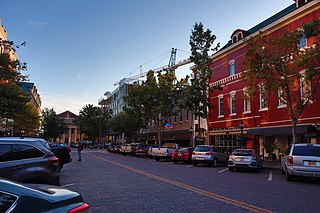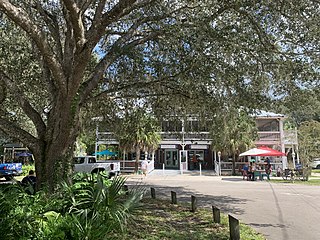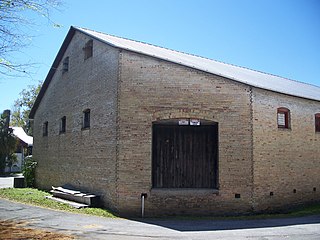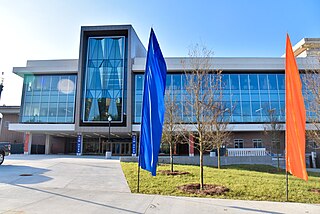History
The Micanopy Historical Society came together in 1983, after the committee finished the work of nominating the Micanopy Historic District to the National Register of Historic Places. [4] The first president of the historical society was John E. Thrasher III. Under the second president Dr. Robert N. Pierce the museum got its start. The original museum was in a storefront in what had been known as "Antique Alley." Historical society members prepared the space, designed displays, and collected and documented local history materials. This location opened in April 1985, with its second display focusing on William Bartram's time in the area. [4] The museum also displays traveling exhibits from both the Museum of Florida History and the Florida State Museum. This location also houses the archives and gift shop, and the lack of space led to the town commission allowing for a storage room at the town hall for overflow items. Under the work of the third president, Dr. Ron Cohen, the search for a larger location began and the Thrasher Warehouse was placed under consideration.
In 1986, the historical society was awarded a matching grant from the Southern Office of the National Trust for Historic Preservation. [5] The $500 grant was used to fund a feasibility study for the potential restoration of the Thrasher Warehouse. The completed feasibility study, along with architect's drawings, were presented to the town commission which approved the renovation project. [4] The development plan was created by the museum's chairman, Tom Brady, with the original plans being restoration of the warehouse, the addition of shops in the storage building behind the warehouse, and the creation of a small restaurant. The proposed development was broken down into three phases, with an estimates cost of $250,000. Phase I would be cleaning the warehouse, attaining rights to the property, creating a not-for-profit organization for the development of the location, and the work of renovating the warehouse for use as a museum. Phase II would focus on renovating the other buildings at the location and the grounds. Phase III would be focused on museum work to finish the project.
A state grant of $69,000 allowed for the completion of the museum renovation. [6] The warehouse was restored to its 1890 condition, with modern additions to meet building codes. The front half of the building was dedicated to exhibits on the history of Micanopy and the North Central Florida area. A request for an additional $85,000 state grant was planned to finish the renovations on the rest of the property.
The museum opened to the public in 1991. [7] A procession of color guard members in period military uniforms marched down Cholokka Boulevard, leading the way to the museum. Historical society president Alyce Tincher made the dedication, and museum chairman Tom Brady discussed the renovation on the building. After the ribbon at the gate was cut the community members entered the new museum.

Alachua County is a county in the north central portion of the U.S. state of Florida. As of the 2020 census, the population was 278,468. The county seat is Gainesville, the home of the University of Florida since 1906, when the campus opened with 106 students.

Gainesville is the county seat of Alachua County, Florida, and the largest city in North Central Florida, with a population of 141,085 in 2020. It is the principal city of the Gainesville metropolitan area, which had a population of 339,247 in 2020.

Hawthorne is a city in Alachua County, Florida, United States, incorporated in 1881. Indigenous peoples of the Americas had been living in the area since around 100 CE; Hawthorne grew around their trading trails. Throughout its history, Hawthorne has been known for its agriculture, railroad, and rural lifestyle. Hawthorne's population was 1,478 at the 2020 census, with an area of 7.38 sq mi (19.1 km2).

Micanopy is a town in Alachua County, Florida, United States, located south of Gainesville. The population as of the 2010 census was 600. The oldest community in the interior of Florida that has been continually inhabited, it has a downtown that is designated as the Micanopy Historic District and listed on the National Register of Historic Places. It contains a number of antique stores, as well as several restaurants, a library, firehouse, and post office. The town's unofficial slogan is "The Town that Time Forgot."

The New-York Historical Society is an American history museum and library in New York City, along Central Park West between 76th and 77th Streets, on the Upper West Side of Manhattan. The society was founded in 1804 as New York's first museum. It presents exhibitions, public programs, and research that explore the history of New York and the nation.

North Central Florida is a region of the U.S. state of Florida which comprises the north-central part of the state and encompasses the North Florida counties of Alachua, Marion, Putnam, Bradford, Columbia, Dixie, Gilchrist, Hamilton, Lafayette, Levy, Madison, Suwannee, Taylor, and Union. The region's largest city is Gainesville, home of the University of Florida and center of the Gainesville metropolitan area, which is the largest metro area in North Central Florida. As of 2020, the region had a population of 575,622 people.

The Hippodrome Theatre is a regional professional theatre in downtown Gainesville, Florida, United States. It was founded in 1973 by local actors and was added to the U.S. National Register of Historic Places on July 10, 1979.

Newnansville, Florida was one of the first American settlements in the interior of Florida. It became the second county seat of Alachua County in 1828, and one of the central locations for activity during the Second Seminole War, during which time it was one of the largest cities in the State. In the 1850s, the Florida Railroad bypassed Newnansville, resulting in the county seat being moved to the new town of Gainesville in 1854. Consequently, Newnansville began to decline, and when a second railway bypassed the town in 1884, most of its residents relocated and formed the new City of Alachua. By 1900, Newnansville was deserted.

The Baird Hardware Company Warehouse is a historic building in Gainesville, Florida, United States. It is located at 619 South Main Street. On November 25, 1985, it was added to the U.S. National Register of Historic Places.

The Old Gainesville Depot is a historic site at 203 Southeast Depot Avenue in Gainesville, Florida. It is located along the Gainesville-Hawthorne Trail State Park.

The 1867 Matheson House is a historic building in Gainesville, Florida, United States. It is located at 528 Southeast 1st Avenue. It was the home of James Douglas Matheson and Augusta Florida Steele Matheson, the daughter of Florida pioneer Augustus Steele, who founded Hillsborough County and Cedar Key. James Douglas Matheson owned a dry goods store in downtown Gainesville and was active in local and state politics, as was his son, eight-term Gainesville mayor Chris Matheson, who was also a state legislator.

Buckman Hall is a historic building located in Murphree Area on the University of Florida campus in Gainesville, Florida, United States. It was designed by architect William A. Edwards in the Collegiate Gothic style and opened in 1906 as one of the two original buildings on the University of Florida's Gainesville campus along with nearby Thomas Hall. It once was a multi-purpose facility but has been used exclusively as a student dormitory since the 1940s.

The Florida Gymnasium is a historic building located on the campus of the University of Florida (UF) in Gainesville. It opened in 1949 as a 7,000-seat multi-purpose arena and served as the home court of the Florida Gators men's basketball team and other UF indoor sports programs for over thirty years, acquiring the nickname of "Alligator Alley" during that time.

The Alachua County Library District (ALCD) is an independent special taxing district and the sole provider of public library service to approximately 280,000 citizens of Alachua County, Florida. This includes all of the incorporated municipalities in the county. It maintains a Headquarters Library and four other branches in Gainesville. There are branch locations in seven of the eight other incorporated municipalities in the county. ACLD also operates a branch at the county jail, and two bookmobiles.
The Louisville and Nashville Depot is an historic Louisville and Nashville Railroad depot located at 206 Henry Street in Milton, Santa Rosa County, Florida. It was built in 1909 on the site of the former Pensacola and Atlantic depot built in 1882 which burned down in 1907. In 1973, the station was closed, but partially restored with a 1976 Bicentennial grant.

The J. Wayne Reitz Union is the student union of the University of Florida, located on Museum Road on the university campus in Gainesville, Florida, United States. The union was named in honor of J. Wayne Reitz, the fifth president of the university, who served from 1955 to 1967. The building, which was originally completed in 1967, contains dining facilities, meeting rooms, offices, a computer lab, a game room, an outdoor amphitheater, retail stores, a movie theater and a hotel.

Jacksonville Historical Society (JHS) is a 501(c)(3) non-profit organization in Jacksonville, Florida, begun by 231 charter members on May 3, 1929 at the Carling Hotel.

The Old Astoria City Hall, now known as the Clatsop County Historical Society Heritage Museum, is a historic building located in Astoria, Oregon, United States, that is listed on the National Register of Historic Places. The building served as the city hall of Astoria from 1905 until 1939. It was the first location of the Columbia River Maritime Museum, from 1963 to 1982, and has been the Heritage Museum since 1985.

The Matheson History Museum Complex is located in Gainesville, Florida. It includes the Matheson History Museum, the Matheson Library & Archives, the 1867 Matheson House, and the Tison Tool Barn.
The East Florida Seminary was an institution of higher learning established by the State of Florida in 1853, and absorbed into the newly established University of Florida in 1905. The school operated in Ocala from 1853 until 1861. After being closed during the Civil War, the school re-opened in Gainesville, Florida in 1866.




















